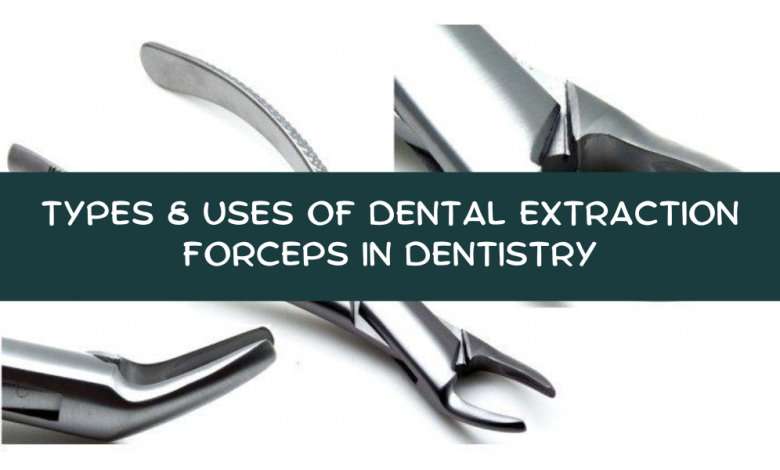Types & Uses of Dental Extraction Forceps In Dentistry

A dental extraction forceps are a must-have tool for orthodontic procedures. When performing extraction treatments, oral care experts utilize them to detach the teeth from the alveolar bones. Its jaws are also shaped to go around the cervical teeth region. The varying extraction forceps are available for dentists to treat specific mouth concerns and areas. They assist in bone expansion.
Moreover, the forceps do not compromise on ergonomics. This is why dental surgeons rely on them for easy adaption for a specific tooth removal. Thus, ensuring a safe and atraumatic tooth removal process. But, the sole goal of every forceps type is to grasp, twist, and extract tooth roots or teeth.
In this write-up, we will discuss the types of dental extracting forceps, their use, and why every dentistry practice must own them.
What is the Use of Dental Extraction Forceps?
Addressing the patient’s oral health concerns involves the use of several tools and quality forceps are simply a must-have. It helps in tooth removal from the socket. Also, luxation is necessary before the extracting process. This ensures there occurs no or minimal damage to the surgical site.
Dental extracting forceps are an essential tool in bone grafting kits and are essential for tooth extraction for a variety of reasons. The tool’s sharp jaws assist in treating the furcation area. The oral surgeons place the forceps on the tooth so that the jaws securely hold the roots underneath the raised soft tissue.
Design of Dental Extraction Forceps
The equipment has two instrument beaks that have huge space in between. It allows easy teeth grasping. Additionally, the forceps are composed of reusable, high-quality stainless steel that is simple to disinfect.
Components of Extraction Forceps
Handle: The oral surgeon conveniently uses the tool ensuring safe and effective treatment, thanks to the serrated handle. The handle’s curved end provides more influence and stability to the fingers, especially the little one. With a wide range of forceps available, you will see most of them curved upwards and beaks in line. Some of them could have a straight handle and a beak that is at a 90-degree angle.
Hinge: The extracting forceps comprise another component called a hinge. It is in the form of a pin or screw type. The dentists get access to have more control over tooth grasping by easily using of handle and beak. However, these require proper care to avoid any chances of damage, especially during the sterilization process.
Beaks: The beaks on the extracting forceps are designed to readily fit around the contour of the tooth crown. Some forceps help to treat single-rooted teeth and come with smooth beaks. Others tend to treat the concerns with multi-rooted teeth. These can better adapt to preserve the tooth furcation because of their pointed beaks.
Type of Dental Extraction Forceps
All these forceps types are manufactured by reputable providers. Also, the variations are available to help dentists meet the patient’s oral health care needs according to the specific concerns. So, let us have a look at these enormous types.
Forceps Frings With Lower Molars
Forceps for lower molars comprise heavy blades. It has sufficient space between the beaks. These are helpful in the removal of mandibular molars. Also, the blades provide a better projection. Its beaks help dentists have complete control over tooth bifurcation. It exerts less pressure on the surgeon’s hand, making it easy to pull out the tooth.
Crown Removing Frings Forceps
It has a solid grip that is necessary and helpful in removing the cast crowns. The best thing is it has enhanced and long beaks. Forceps for crown removal help the dentists to lower the possibilities of crown fracture. Such tools, which use auto-retractable technology, do not require manual efforts to open forceps.
In addition, less force and tension are put on the hands during the treatment facilitating better control. The extraction forceps are lightweight in design. It means dentists can stay more comfortable and conveniently use it every day. Moreover, it is usually designed with quality stainless steel. Thus, ensuring improved durability.
Upper Canine Forceps
These are straight dental extraction forceps comprising heavy blades. Such equipment usually helps dentists to remove maxillary central incisors. Also, they can use it to treat the incisions of the mouth’s left and right quadrants.
Forceps for Anterior Teeth
These forceps have narrow beaks. It comes with no gap in between the equipment’s blades. Dentists must have this tool in their practice to treat anterior teeth. The beak design and shape are conical and straight. Thus, conforming to the structure of the patient’s teeth. In addition, it helps preserve the anterior roots. The dentists can use it for left and right upper mouth quadrants as well.
Upper Molar Forceps for Atraumatic Extraction
Two bend-shaped blades are present in upper molar forceps. One gives a larger mouth projection and is known as buccal. The palatal blade is an additional blade. Both its design and function are smooth. The maxillary molar roots’ bifurcation is accommodated by the projection. Additionally, dentists can treat tooth roots both in the left and right quadrants using different forceps.
How to Sterilize Dental Extracting Forceps
The use of any dental extraction tools like forceps or rongeurs requires sterilization. The reason is these are inserted deep into the mouth areas, and tooth roots. It means treating another patient with the same tool without sterilizing can increase the chances of infection transmission. Plus, the debris leftover can result in contamination.
Hence, following the cleaning and sterilizing instructions is essential. It will keep the instrument damage-free and guarantee durability. Also, preventing the infection spread becomes easy.
Conclusion
No matter if it is about one tooth removal or multiple simultaneously, suitable equipment can help improve the practice. Thus, delivering safe treatment to the patients. Extraction forceps are an essential tool that every dentist must own. However, not one forceps can address varying patients’ oral health issues. Hence, above are some basic and necessary forceps types that every dental surgeon must have. For some, these may help in performing atraumatic teeth extraction. On the other hand, other dentists can use them to experience lowered tissue trauma.




